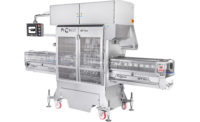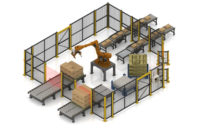Static Electricity: Where does it come from and how can it be controlled in web converting applications?
You walk across the carpet, reach for the light switch and……….ZAP!! You get a shock. That’s static electricity alright, but in industrial manufacturing environments, it’s a little bit more complicated.
By definition, static electricity is an electrical charge at rest caused by an imbalance of electrons. The imbalance of electrons occurs when two surfaces are brought into close intimate contact and are then separated. If you remember in science class, all elements in nature are trying to maintain equilibrium or balance. So in the example above, when your feet are in contact with the carpet, there is an alignment of electrons as each surface tries to balance with the other. When the surfaces are separated, an exchange of electrons takes place, leaving one surface with an overabundance of electrons, or is negatively charged, while the other surface has a deficiency of electrons and is positively charged.
To complete the example of walking across the carpet and getting a shock, you get a shock because your body is a conductor of electricity that was isolated from electrical ground during the charging event and arced to ground when you reached for the light switch. This phenomenon of static charge generation from contacting and separating surfaces is known as “triboelectrification, or tribocharging” resulting from the friction between the two surfaces.
Controlling Static
In order to control static electricity, you first have to have a clear understanding of the differences between conductive and insulative materials. Conductive materials (such as metals) have the ability to conduct electricity. As such, when connected to an electrical ground, conductors have the ability to bleed or dissipate electrical charges. Insulative materials, on the other hand (such as plastic film or coated paper) have no electrical capabilities, and as a result, cannot be grounded to eliminate the electrical charge. For these insulators, the charge resides on the surface and can only be eliminated by bringing the opposite polarity charge to the surface via air ionization.
In packaging or converting applications, these electrical charges are generated from the constant contact and separation (friction) of the web from the time it leaves the un-wind roll at the start of the process, through the web handling idler rollers, coating stations and many other operations that might be included in the process until completion at the re-wind roll. Unfortunately, static charges are cumulative in nature, with each friction event generating more charge to the surface of the material. The volume of charge is also impacted by the materials involved in the friction event. A 5kV charge, as an example, generated as the web passes over a steel idler roller, could jump to 25kV after the web passes through the coating station and separates from a rubber coated nip roller used at the coater. All of this is further complicated by the speed and materials used in the process. For this reason, it is important to work closely with an experienced static control advisor who understands your application and knows how to use ionization devices strategically to control static electricity. Like in anything else, using the right tool for the job delivers the best solution quickly and efficiently.
Simco-Ion is excited to introduce a new level of static neutralizing with the IQ Easy Platform. The IQ Easy System includes two varieties of static neutralizing bars, a sensor bar and a manager. All are equipped with the unique feature of 24V DC supply voltage. This combination of components and technologies offers unprecedented static neutralizing performance and simplified installation with low voltage wiring. The IQ Easy starts by pairing a static neutralizing bar with sensor bar, offering a true closed-loop static solution based on multiple patented features. The heart of the system is the IQ Easy Manager. This control unit provides direct ionization output monitoring, target charge level monitoring, as well as maintenance and fault indicators for up to 6 devices.
Static Neutralizing Bars
IQ Easy static neutralizing bars are uniquely engineered with an integrated high voltage power supplies requiring a low voltage input of only 24 DC, resulting in a safer and cleaner install. The bars are made with a rugged, reinforced extrusion, as well as shockless, long-life emitter pins for maximum performance. Highly visible status LEDs on the end of the neutralizer quickly let you know the status. Each bar is designed with a standard M12 connector, offered in a straight or angled connection. These bars are IP66 rated against dust and splash, giving you extra protection with over 60 different static neutralizing bar lengths available within the IQ Easy line, going up to 13 feet.
The IQ Easy Sensor bar is used to measure the field intensity of a charged web or target across the web. Various design configurations in over 40 different bar lengths available, allowing you to position the sensors in a customized way to acquire a complete understanding of electrostatic charge issues you may be experiencing.
The Sensor bar is used in conjunction with the IQ Easy Manager. Using our proprietary closed-looped feedback system, the Sensor bar can control the static neutralizing bar. Meaning as the Sensor bar reads the downstream charge, the ionization being produced from the neutralizing bar will adjust as needed in real time to ensure that you are receiving the lowest possible residual static charge.
The whole IQ Easy system all comes back to the Manager. This powerful unit provides ultimate monitoring and control over the system. Its 7” touch screen interface lets you easily navigate to monitor system statuses and edit parameters. Large color-coded icons on the home screen of the Manager quickly give you a status of each connected device, including warning and/or fault as well as user set alarm outputs. As you move further into the Manager, you’ll access all device and process parameters, including the valuable upstream charge reading. The 24V provides power to all devices in the system. PLC integration through various fieldbus interfaces, as well as customizable data and event logging are accessible through the Manager.
Static electricity is an age-old problem in packaging and converting operations, such as slitting, printing, coating, and many other applications. However, gone are the days of just adding a basic static bar or some sort of passive ionizer to solve the issues that consistently incur in modern machinery and quality demands. High efficiency static neutralizing equipment is significantly improved from initial industry offerings. Today’s static systems are scalable and can range from a static bar with power supply to a full monitored system that incorporates interface with machine’s control systems, all to help make your job of controlling static….well, Easy.
Simco-Ion
www.simco-ion.com




